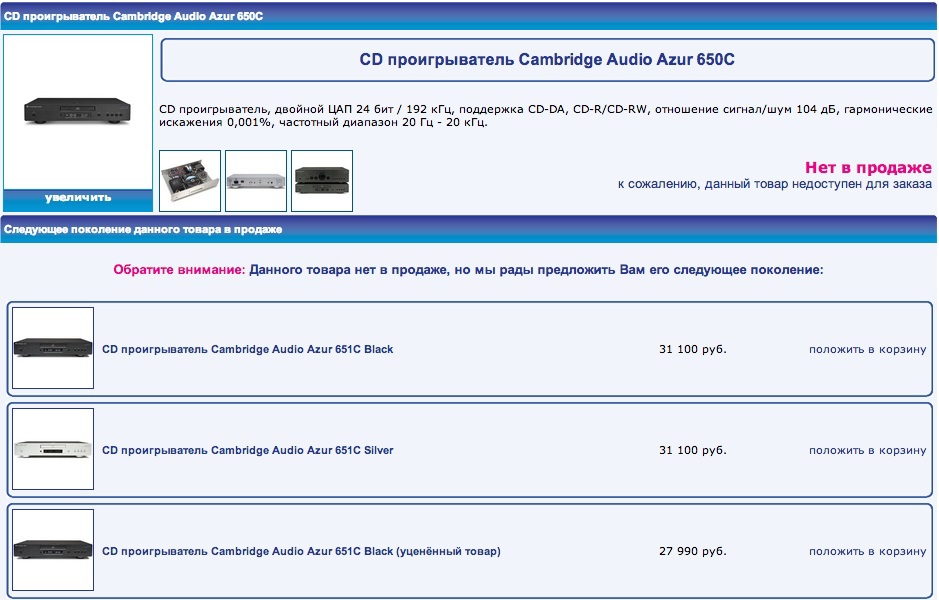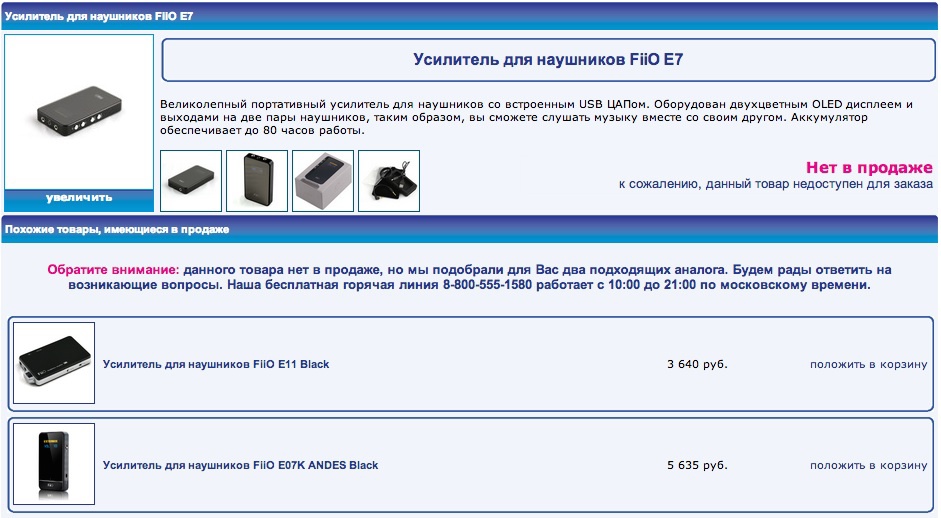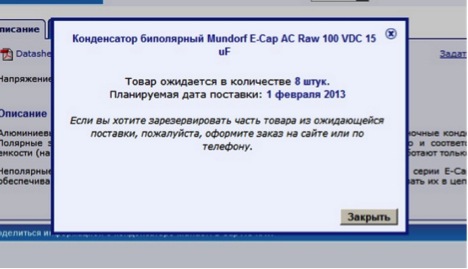How to improve the quality of customer service if the required goods are not available
 A rare online store has never encountered the problem of a lack of goods in stock. The impact of this problem extends far beyond the loss of sales of an individual product. Because of this, customer satisfaction from the purchase decision may be reduced, and in the future this may lead to the buyer choosing another store or brand. So, how is it possible to solve the problem of the lack of goods in the warehouse that online stores face today? We decided to look into this issue using the example of the experience of Audiomania.
A rare online store has never encountered the problem of a lack of goods in stock. The impact of this problem extends far beyond the loss of sales of an individual product. Because of this, customer satisfaction from the purchase decision may be reduced, and in the future this may lead to the buyer choosing another store or brand. So, how is it possible to solve the problem of the lack of goods in the warehouse that online stores face today? We decided to look into this issue using the example of the experience of Audiomania.First of all, it is worth noting that in the Russian Internet market there are very few companies that write about the presence / absence of goods in stock. Therefore, the conversion can be increased by simply indicating whether the product is currently available. Of course, there are situations when the product necessary for the buyer ends at several stores at the same time (this happens especially often if several stores purchase goods from one supplier). In this case, the buyer, having arrived at the site where there is no information about the absence of the required product in the warehouse, is likely to try to buy it (and increase the conversion even if the product really is out of stock), but the value of the conversion obtained in this way will be small: for all the attractiveness store metrics in Yandex. Metric or Google Analytics real sales with such "purchases" does not happen. Therefore, honesty in this case is indeed the best policy.
In addition to clearly recording the absence / availability of goods (it is important, by the way, that the user sees this information before placing an order), a number of proactive steps can be taken to help keep the customer. First of all, you need to offer alternatives. According to the experience of Audiomania, depending on the situation, replacement products should be recommended in different ways.
Option 1:
If the product is discontinued and is no longer delivered to stores, you must honestly tell about it. If a manufacturer has replaced an obsolete model with a newer one, it is logical to immediately offer it for replacement (provided that it is the same manufacturer, the same type of product and the price of the new model differs slightly from the old one). At the same time, our experience suggests that such an offer suits customers - a user who comes for an outdated model receives an updated version for almost the same money - which, of course, does not give the slightest reason for doubt.

In place of the outdated Cambridge Audio CD player model, we offer a new generation of products from the same manufacturer
Option 2:
Sometimes (in the case of audio technology this happens), the manufacturer replaces the outdated model with a new one so that the changes are not visible to the end user (for example, the model gets an alphanumeric name slightly different from the name of the predecessor device, but the product with from the point of view of consumer qualities practically does not change) - in such cases, we immediately redirect the user to the page with the new model. We take the same approach if the manufacturing company changes its name for one reason or another, which also happens in the world of audio technology. At the same time, the user sees that he was redirected from the page of the desired product but a new one (usually for the “transition period" in brackets to the updated name of the product we add the old designation).
Option 3:
It also happens that in the product line of the brand there is no clear product-follower of the discontinued model. At the same time, there is a product of the same brand, similar in functionality and price to the desired one, but coming out in a different line, and alternative products of other manufacturers. In this case, the priority in the demonstration of alternatives should, of course, be given to the desired brand.

The closest analogues to the desired amplifier are products of the same manufacturing company
Option 4:
If there is no obvious replacement for the missing product within the same brand, it is necessary to offer alternative products of the same category, but from other manufacturers. The price may fluctuate within ± 10% of the price of the desired product. We recommend that you always offer the user not only a product at a reasonable price, but also a little more expensive than the desired one - usually the price is not the main criterion when searching for a product (the main thing for the buyer is not so much the cost of the product, but the opportunity to solve the problem facing him), therefore, offering such option gives a good opportunity to do upsale. This option is the simplest, and we recommend using it when there is no way to give the user any more personalized recommendations.
Option 5:
If for one reason or another your online store has stopped working with any brand, it is better to tell the user about it. And offer products of another brand, which can be a worthy alternative to the desired. Moreover, the more targeted the recommendation, the higher will be its effectiveness. At Audiomania, we compose individual texts for each missing product (we monitor this especially carefully when updating the product line).
Another opportunity to keep the buyer is to place a form on the page of the missing (temporarily) product, by filling out which the user can receive notifications by mail in case the product appears in stock. This tool can be very useful, but you need to handle it carefully. And first of all, carefully monitor what pages the form is placed on - if the goods are discontinued and will never be delivered to the store (in this case, it is much better to pay attention to paragraph 1 and paragraph 5 from the list above), such information on its page will be at least useless (and in the worst case, it may cause disappointment for the buyer, who will waste time in vain waiting for the letter). A subscription is especially useful if the company has a small warehouse and the range is significant. In such a situation, the probability
In Audiomania, we carefully monitor the delivery of each product and try to give customers as detailed information as possible about the expected deliveries. Thus, when the user gets to the product page, which is currently not available, but delivery is planned in the near future, he sees information on how many days the goods will arrive.

The user knows when the next delivery of goods is expected.
In addition, knowing exactly when the goods will arrive, we offer the user to place a pre-order (this is especially true for goods that are very popular). After pre-ordering, the goods are placed “in reserve” upon arrival at the warehouse, and a letter is sent to the user stating that a reserved purchase is waiting for him, which is useful if, for example, the user is currently unable to redeem the goods immediately (on vacation or simply busy) - this is how the product is guaranteed to wait for it, even if it is an overly popular model. In addition, this approach allows you to keep the buyer much more reliable than a subscription to the mailing list. Such a policy is perfect for those companies that are owners of large storage facilities and know exactly when they will receive a particular product.

The opportunity to pre-order is available along with information on the nearest deliveries.
So, a brief list of our tips for working with goods that are currently not available is as follows:
- Always give the user maximum information about the product before he puts it in the basket. Be sure to give the user information if: the product is not in stock; product / brand name has changed; the brand discontinued the desired model; You have stopped working with the brand.
- Always offer an alternative. Give priority to alternatives to products of the brand you are looking for.
- Strive to ensure that the price of an alternative product differs from the sought one within ± 10%. Be sure to offer a more expensive product: far from always the price for the client is a decisive factor when buying.
- Use the subscription forms so that the user can receive an alert in case of receipt of goods at the warehouse. Do not place such forms on the pages of goods whose deliveries have ceased and will not resume. Prefer mail alerts if your store’s assortment is large and storage facilities are modest.
- Offer customers pre-order goods, if you know exactly when it will arrive at the warehouse. This is especially true for companies with large storage facilities and a clear delivery schedule.
